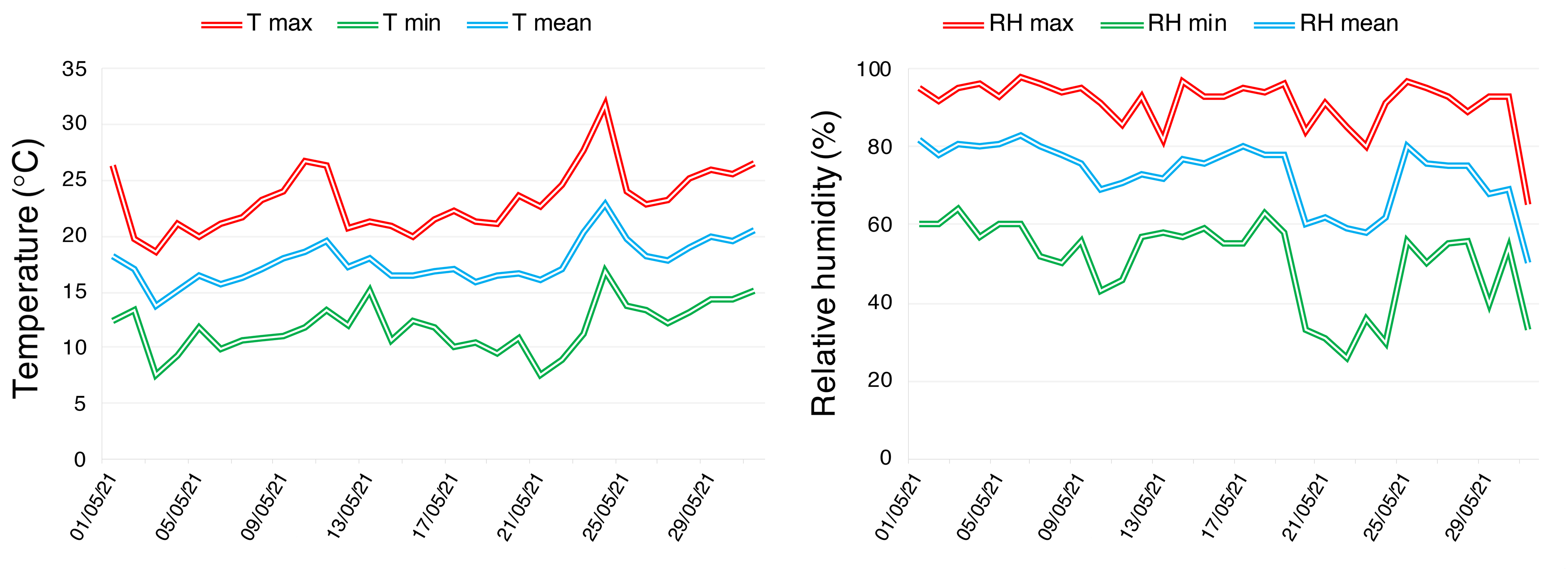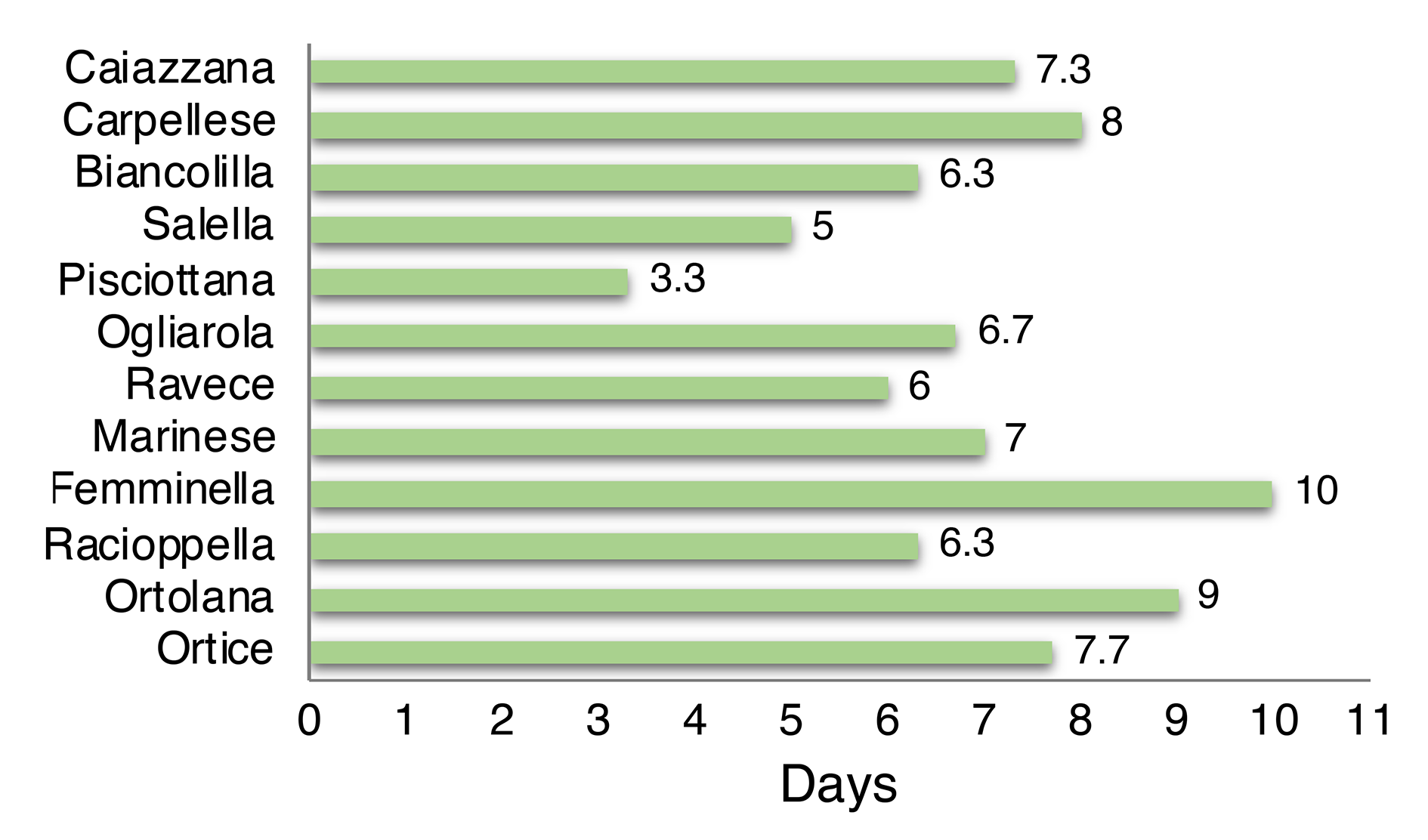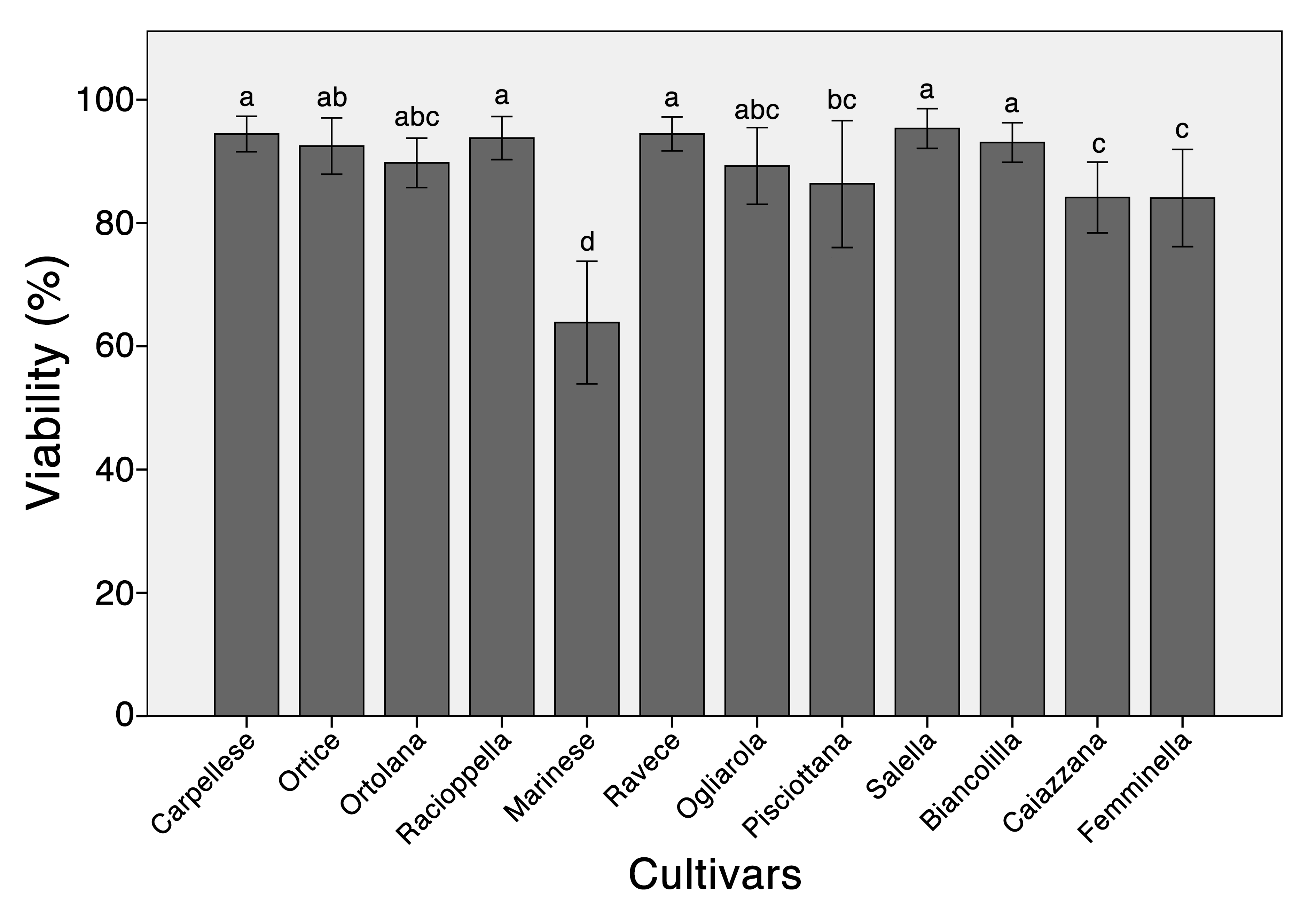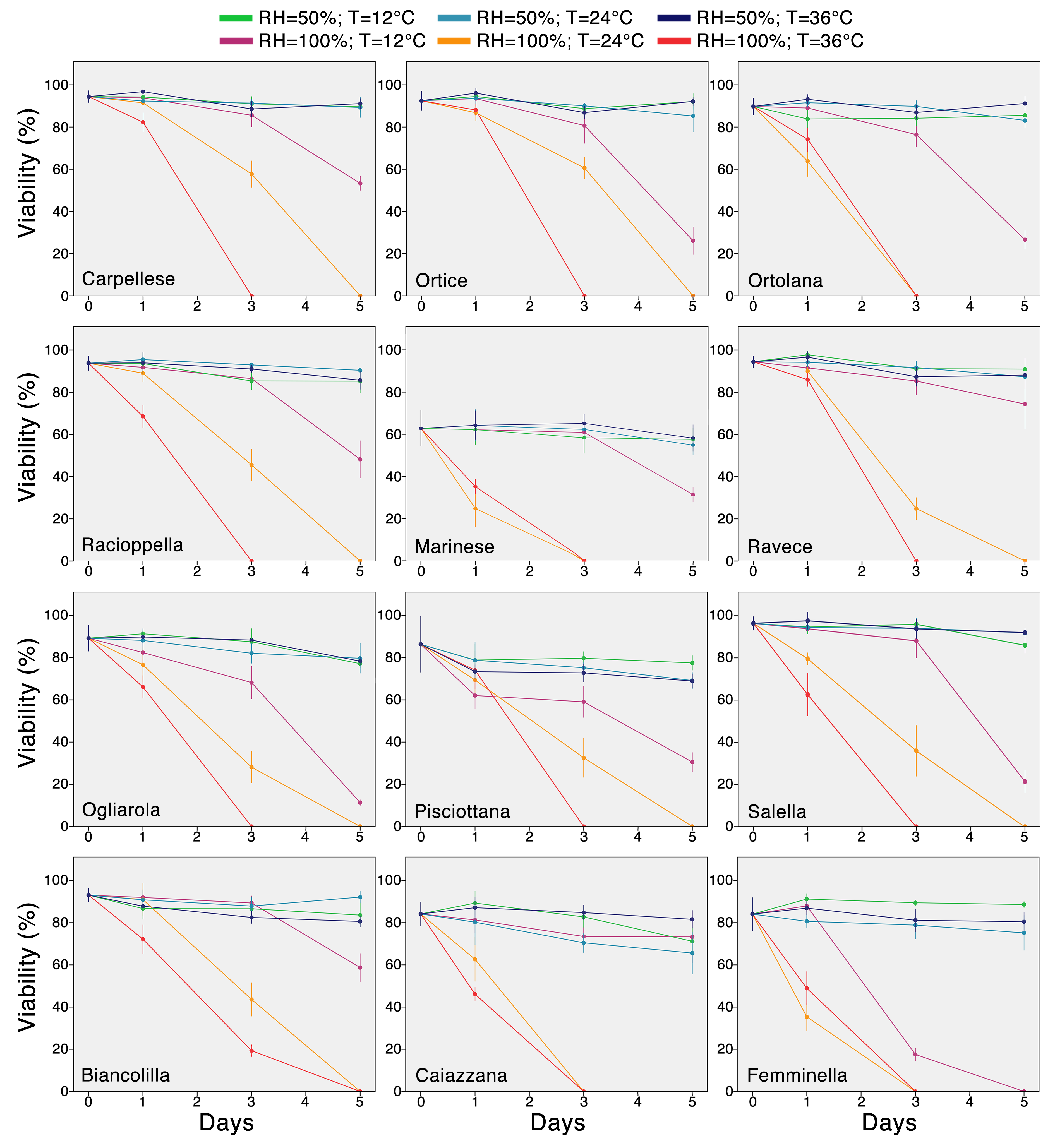High Temperature and Humidity Affect Pollen Viability and Longevity in Olea europaea L.
Abstract
:1. Introduction
2. Materials and Methods
2.1. Plant Material and Flowering Monitoring
2.2. Temperature and Humidity Treatments
2.3. Analysis of Pollen Viability
2.4. Data Analyses
3. Results
3.1. Climatic Parameters
3.2. Flowering Time
3.3. Pollen Viability
4. Discussion
4.1. Climatic Parameters and Flowering
4.2. Pollen Viability
5. Conclusions
Author Contributions
Funding
Data Availability Statement
Acknowledgments
Conflicts of Interest
References
- Giorgi, F. Climate change hot-spots. Geophys. Res. Lett. 2006, 33, 1–4. [Google Scholar] [CrossRef]
- Giannakopoulos, C.; Le Sager, P.; Bindi, M.; Moriondo, M.; Kostopoulou, E.; Goodess, C.M. Climatic changes and associated impacts in the Mediterranean resulting from a 2 °C global warming. Glob. Planet. Chang. 2009, 68, 209–224. [Google Scholar] [CrossRef]
- Gualdi, S.; Somot, S.; Li, L.; Artale, V.; Adani, M.; Bellucci, A.; Braun, A.; Calmanti, S.; Carillo, A.; Dell’Aquila, A.; et al. The circe simulations: Regional climate change projections with realistic representation of the mediterranean sea. Bull. Am. Meteorol. Soc. 2013, 94, 65–81. [Google Scholar] [CrossRef]
- Dell’Aquila, A.; Calmanti, S.; Ruti, P.; Struglia, M.V.; Pisacane, G.; Carillo, A.; Sannino, G. Effects of seasonal cycle fluctuations in an A1B scenario over the Euro-Mediterranean region. Clim. Res. 2012, 52, 135–157. [Google Scholar] [CrossRef] [Green Version]
- Arenas-Castro, S.; Gonçalves, J.F.; Moreno, M.; Villar, R. Projected climate changes are expected to decrease the suitability and production of olive varieties in southern Spain. Sci. Total Environ. 2020, 709, 136161. [Google Scholar] [CrossRef] [PubMed]
- Benlloch-González, M.; Sánchez-Lucas, R.; Benlloch, M.; Ricardo, F.E. An approach to global warming effects on flowering and fruit set of olive trees growing under field conditions. Sci. Hortic. 2018, 240, 405–410. [Google Scholar] [CrossRef]
- Cirillo, A.; Conti, S.; Graziani, G.; El-Nakhel, C.; Rouphael, Y.; Ritieni, A.; Di Vaio, C. Mitigation of High-Temperature Damage by Application of Kaolin and Pinolene on Young Olive Trees (Olea europaea L.): A Preliminary Experiment to Assess Biometric, Eco-Physiological and Nutraceutical Parameters. Agronomy 2021, 11, 1884. [Google Scholar] [CrossRef]
- Galán, C.; García-Mozo, H.; Vázquez, L.; Ruiz, L.; De La Guardia, C.D.; Trigo, M.M. Heat requirement for the onset of the Olea europaea L. pollen season in several sites in Andalusia and the effect of the expected future climate change. Int. J. Biometeorol. 2005, 49, 184–188. [Google Scholar] [CrossRef]
- Tupper, N. Spanish Olive Oil Under Constant Threat from Climate Change. Available online: https://www.oliveoiltimes.com/world/spanish-olive-oil-under-constant-threat-from-climate-change/29618 (accessed on 20 December 2021).
- Ozdemir, Y. Effects of Climate Change on Olive Cultivation and Table Olive and Olive Oil Quality. Horticulture 2016, 60, 65–69. [Google Scholar]
- De Micco, V.; Scala, M.; Aronne, G. Effects of simulated microgravity on male gametophyte of Prunus, Pyrus, and Brassica species. Protoplasma 2006, 228, 121–126. [Google Scholar] [CrossRef]
- Osborne, C.P.; Chuine, I.; Viner, D.; Woodward, F.I. Olive phenology as a sensitive indicator of future climatic warming in the Mediterranean. Plant Cell Environ. 2000, 23, 701–710. [Google Scholar] [CrossRef] [Green Version]
- Moriondo, M.; Stefanini, F.M.; Bindi, M. Reproduction of olive tree habitat suitability for global change impact assessment. Ecol. Modell. 2008, 218, 95–109. [Google Scholar] [CrossRef]
- Ponti, L.; Gutierrez, A.P.; Ruti, P.M.; Dell’Aquila, A. Fine-scale ecological and economic assessment of climate change on olive in the Mediterranean Basin reveals winners and losers. Proc. Natl. Acad. Sci. USA 2014, 111, 5598–5603. [Google Scholar] [CrossRef] [PubMed] [Green Version]
- Rubio, R.; Balaguer, L.; Manrique, E.; Pérez, M.E.; Vargas, P. On the historical presence of the wild olive [Olea europaea L. var. Sylvestris (Miller): Lehr.(Oleaceae)] in the Eurosiberian region of the Iberian Peninsula. In Anales del Jardín Botánico de Madrid; Consejo Superior de Investigaciones Científicas: Madrid, Spain, 2002; Volume 59, No. 2; pp. 342–344. [Google Scholar]
- Olesen, J.E.; Trnka, M.; Kersebaum, K.C.; Skjelvåg, A.O.; Seguin, B.; Peltonen-Sainio, P.; Rossi, F.; Kozyra, J.; Micale, F. Impacts and adaptation of European crop production systems to climate change. Eur. J. Agron. 2011, 34, 96–112. [Google Scholar] [CrossRef]
- Poljuha, D.; Sladonja, B.; Šetić, E.; Milotić, A.; Bandelj, D.; Jakše, J.; Javornik, B. DNA fingerprinting of olive varieties in Istria (Croatia) by microsatellite markers. Sci. Hortic. 2008, 115, 223–230. [Google Scholar] [CrossRef]
- Ayed, R.B.; Grati-Kamoun, N.; Moreau, F.; Rebaï, A. Comparative study of microsatellite profiles of DNA from oil and leaves of two Tunisian olive cultivars. Eur. Food Res. Technol. 2009, 229, 757–762. [Google Scholar] [CrossRef]
- Rallo, P.; Dorado, G.; Martín, A. Development of simple sequence repeats (SSRs) in olive tree (Olea europaea L.). Theor. Appl. Genet. 2000, 101, 984–989. [Google Scholar] [CrossRef]
- Marra, F.P.; Caruso, T.; Costa, F.; Di Vaio, C.; Mafrica, R.; Marchese, A. Genetic relationships, structure and parentage simulation among the olive tree (Olea europaea L. subsp. europaea) cultivated in Southern Italy revealed by SSR markers. Tree Genet. Genomes 2013, 9, 961–973. [Google Scholar] [CrossRef]
- Di Vaio, C.; Nocerino, S.; Paduano, A.; Sacchi, R. Characterization and evaluation of olive germplasm in southern Italy. J. Sci. Food Agric. 2013, 93, 2458–2462. [Google Scholar] [CrossRef] [Green Version]
- Cicatelli, A.; Fortunati, T.; De Feis, I.; Castiglione, S. Oil composition and genetic biodiversity of ancient and new olive (Olea europea L.) varieties and accessions of southern Italy. Plant Sci. 2013, 210, 82–92. [Google Scholar] [CrossRef]
- Martin, G.C. Olive flower and fruit production dynamics. Acta. Hortic. 1990, 286, 141–153. [Google Scholar] [CrossRef]
- Lavee, S.; Rallo, L.; Rapoport, H.F.; Troncoso, A. The floral biology of the olive: Effect of flower number, type and distribution on fruitset. Sci. Hortic. 1996, 66, 149–158. [Google Scholar] [CrossRef] [Green Version]
- Fernández-Escobar, R.; Gomez-Valledor, G.; Rallo, L. Influence of pistil extract and temperature on in vitro pollen germination and pollen tube growth of olive cultivars. J. Hortic. Sci. 1983, 58, 219–227. [Google Scholar] [CrossRef]
- Vuletin Selak, G.; Perica, S.; Goreta Ban, S.; Poljak, M. The effect of temperature and genotype on pollen performance in olive (Olea europaea L.). Sci. Hortic. 2013, 156, 38–46. [Google Scholar] [CrossRef]
- Biondi, E.; Casavecchia, S.; Pesaresi, S. Nitrophilous and ruderal species as indicators of climate change. Case study from the Italian Adriatic coast. Plant Biosyst. 2012, 146, 134–142. [Google Scholar] [CrossRef]
- Aronne, G.; Buonanno, M.; De Micco, V. Reproducing under a warming climate: Long winter flowering and extended flower longevity in the only Mediterranean and maritime Primula. Plant Biol. 2014, 17, 535–544. [Google Scholar] [CrossRef] [PubMed]
- Aronne, G.; De Micco, V.; Scala, M. Effects of relative humidity and temperature conditions on pollen fluorochromatic reaction of Rosmarinus officinalis L. (Lamiaceae). Protoplasma 2006, 228, 127–130. [Google Scholar] [CrossRef] [PubMed]
- Mousa, Y.M.; Gerasopoulos, D.; Metzidakis, I.; Kiritsakis, A. Effect of altitude on fruit and oil quality characteristics of “Mastoides” olives. J. Sci. Food Agric. 1996, 71, 345–350. [Google Scholar] [CrossRef]
- Kiritsakis, A.; Markakis, P. Olive oil: A review. Adv. Food Res. 1987, 31, 453–482. [Google Scholar] [PubMed]
- Ridolfi, M.; Terenziani, S.; Patumi, M.; Fontanazza, G. Characterization of the lipoxygenases in some olive cultivars and determination of their role in volatile compounds formation. J. Agric. Food Chem. 2002, 50, 835–839. [Google Scholar] [CrossRef] [PubMed]
- Di Vaio, C.; Nocerino, S.; Paduano, A.; Sacchi, R. Influence of some environmental factors on drupe maturation and olive oil composition. J. Sci. Food Agric. 2013, 93, 1134–1139. [Google Scholar] [CrossRef]
- Ledesma, N.A.; Kawabata, S. Responses of two strawberry cultivars to severe high temperature stress at different flower development stages. Sci. Hortic. 2016, 211, 319–327. [Google Scholar] [CrossRef]
- Iovane, M.; Aronne, G. High temperatures during microsporogenesis fatally shorten pollen lifespan. Plant Reprod. 2021, in press. [Google Scholar] [CrossRef] [PubMed]
- Ferri, A.; Giordani, E.; Padula, G.; Bellini, E. In vitro germinability of pollen grains of olive of new genotypes obtained advanced selections. Italus Hortus. 2009, 16, 77–81. [Google Scholar]
- Koubouris, G.C.; Metzidakis, I.T.; Vasilakakis, M.D. Impact of temperature on olive (Olea europaea L.) pollen performance in relation to relative humidity and genotype. Environ. Exp. Bot. 2009, 67, 209–214. [Google Scholar] [CrossRef]
- Dafni, A. Pollination Ecology: A Practical Approach; Oxford University Press: Oxford, UK, 1992. [Google Scholar]
- Dafni, A.; Firmage, D. Pollen viability and longevity: Practical, ecological and evolutionary implications. Plant Syst. Evol. 2000, 222, 113–132. [Google Scholar] [CrossRef]
- Rapoport, H.F.; Rallo, L. Postanthesis Flower and Fruit Abscission in Manzanillo’Olive. Am. Soc. Hortic. Sci. 1991, 116, 720–723. [Google Scholar] [CrossRef] [Green Version]
- Giorgi, F.; Nielsen, P.; Ozdemir, Y.; Giannakopoulos, C.; Le Sager, P.; Bindi, M.; Moriondo, M.; Kostopoulou, E.; Goodess, C.M. Coastal and estuarine processes. Coast. Estuar. Process. 2009, 33, 1–360. [Google Scholar] [CrossRef] [Green Version]
- Biesbroek, G.R.; Swart, R.J.; Carter, T.R.; Cowan, C.; Henrichs, T.; Mela, H.; Morecroft, M.D.; Rey, D. Europe adapts to climate change: Comparing National Adaptation Strategies. Glob. Environ. Chang. 2010, 20, 440–450. [Google Scholar] [CrossRef]
- Mastrocicco, M.; Busico, G.; Colombani, N. Deciphering interannual temperature variations in springs of the Campania region (Italy). Water 2019, 11, 288. [Google Scholar] [CrossRef] [Green Version]
- Smirnova, A.; Leide, J.; Riederer, M. Deficiency in a Very-Long-Chain Fatty Acid-Ketoacyl-Coenzyme A Synthase of Tomato Impairs Microgametogenesis and Causes Floral Organ Fusion. Plant Physiol. 2013, 161, 196–209. [Google Scholar] [CrossRef] [Green Version]
- Di Vaio, C. Caratterizzazione morfologica e bio-agronomica delle cultivar campane di olivo. In Il Germoplasma Dell’olivo in Campania; Regione Campania: Napoli, Italy, 2012; pp. 17–26. [Google Scholar]
- Fornaciari, M.; Romano, B.; Pieroni, L.; Ciuchi, P. A regression model for the start of the pollen season in Olea eropaea. Grana 1998, 37, 110–113. [Google Scholar] [CrossRef]
- Schwartz, M.D. Advancing to full bloom: Planning phenological research for the 21st century. Int. J. Biometeorol. 1999, 42, 113–118. [Google Scholar] [CrossRef]
- Orlandi, F.; Bonofiglio, T.; Ruga, L.; Sgromo, C.; Romano, B.; Fornaciari, M. Relationships between vegeta-tive-reproductive phases of plant species and the meteorological variables in a phenological garden of Central Italy. Ital. J. Agrometeorol. Riv. Ital. Agrometeorol. 2010, 15, 35–43. [Google Scholar]
- Orlandi, F.; Ruga, L.; Romano, B.; Fornaciari, M. Olive flowering as an indicator of local climatic changes. Theor. Appl. Climatol. 2005, 81, 169–176. [Google Scholar] [CrossRef]
- Bonofiglio, T.; Orlandi, F.; Sgromo, C.; Romano, B.; Fornaciari, M. Influence of temperature and rainfall on timing of olive (Olea europaea) flowering in Southern Italy. N. Z. J. Crop Hortic. Sci. 2008, 36, 59–69. [Google Scholar] [CrossRef]
- Montemurro, C.; Dambruoso, G.; Bottalico, G.; Sabetta, W. Self-incompatibility assessment of some italian olive genotypes (Olea europaea L.) and cross-derived seedling selection by ssr markers on seed endosperms. Front. Plant Sci. 2019, 10, 1–13. [Google Scholar] [CrossRef] [Green Version]
- Wu, S.B.; Collins, G.; Sedgley, M. Sexual compatibility within and between olive cultivars. J. Hortic. Sci. Biotechnol. 2002, 77, 665–673. [Google Scholar] [CrossRef]
- Ferrara, G.; Camposeo, S.; Palasciano, M.; Godini, A. Production of total and stainable pollen grains in Olea europaea L. Grana 2007, 46, 85–90. [Google Scholar] [CrossRef]
- Aguilera, F.; Ruiz Valenzuela, L. Time trend in the viability of pollen grains in the Picual olive (Olea europaea L.) cultivar. Palynology 2013, 37, 28–34. [Google Scholar] [CrossRef]
- Marchese, A.; Marra, F.P.; Costa, F.; Quartararo, A.; Fretto, S.; Caruso, T. An investigation of the self- and inter-incompatibility of the olive cultivars “Arbequina” and “Koroneiki” in the Mediterranean climate of Sicily. Aust. J. Crop Sci. 2016, 10, 88–93. [Google Scholar]
- Pacini, E.; Dolferus, R. Pollen developmental arrest: Maintaining pollen fertility in a world with a changing climate. Front. Plant Sci. 2019, 10, 1–15. [Google Scholar] [CrossRef] [PubMed]
- Firon, N.; Nepi, M.; Pacini, E. Water status and associated processes mark critical stages in pollen development and functioning. Ann. Bot. 2012, 109, 1201–1213. [Google Scholar] [CrossRef] [Green Version]
- Heslop-Harrison, J. An Interpretation of the Hydrodynamics of Pollen. Am. J. Bot. 1979, 66, 737–743. [Google Scholar] [CrossRef]
- Franchi, G.G.; Nepi, M.; Dafni, A.; Pacini, E. Partially hydrated pollen: Taxonomic distribution, ecological and evolutionary significance. Plant Syst. Evol. 2002, 234, 211–227. [Google Scholar] [CrossRef]
- Aylor, D.E.; Baltazar, B.M.; Schoper, J.B. Some physical properties of teosinte (Zea mays subsp. parviglumis) pollen. J. Exp. Bot. 2005, 56, 2401–2407. [Google Scholar] [CrossRef] [PubMed]
- Buitink, J.; Leprince, O. Glass formation in plant anhydrobiotes: Survival in the dry state. Cryobiology 2004, 48, 215–228. [Google Scholar] [CrossRef]
- Kravets, E.A. Cytomixis and its role in the regulation of plant fertility. Russ. J. Dev. Biol. 2013, 44, 113–128. [Google Scholar] [CrossRef]
- Hinojosa, L.; Matanguihan, J.B.; Murphy, K.M. Effect of high temperature on pollen morphology, plant growth and seed yield in quinoa (Chenopodium quinoa Willd.). J. Agron. Crop Sci. 2019, 205, 33–45. [Google Scholar] [CrossRef] [Green Version]
- Kotak, S.; Larkindale, J.; Lee, U.; von Koskull-Döring, P.; Vierling, E.; Scharf, K.D. Complexity of the heat stress response in plants. Curr. Opin. Plant Biol. 2007, 10, 310–316. [Google Scholar] [CrossRef]
- Larkindale, J.; Vierling, E. Core genome responses involved in acclimation to high temperature. Plant Physiol. 2008, 146, 748–761. [Google Scholar] [CrossRef] [Green Version]
- Scharf, K.D.; Berberich, T.; Ebersberger, I.; Nover, L. The plant heat stress transcription factor (Hsf) family: Structure, function and evolution. Biochim. Biophys. Acta (BBA)-Gene Regul. Mech. 2012, 1819, 104–119. [Google Scholar] [CrossRef] [PubMed]
- AL-Quraan, N.A.; Locy, R.D.; Singh, N.K.; Sun, W.; Montagu, M.; Van Verbruggen, N. Small heat shock proteins and stress toler. Plant Physiol. Biochem. 2002, 1577, 1–9. [Google Scholar]
- Hong, S.W.; Vierling, E. Mutants of Arabidopsis thaliana defective in the acquisition of tolerance to high temperature stress. Proc. Natl. Acad. Sci. USA 2000, 97, 4392–4397. [Google Scholar] [CrossRef] [PubMed] [Green Version]
- Assab, E.; Rampino, P.; Mita, G.; Perrotta, C. Heat shock response in olive (Olea europaea L.) twigs: Identification and analysis of a cDNA coding a class I small heat shock protein. Plant Biosyst. 2011, 145, 419–425. [Google Scholar] [CrossRef]




| N | Province | Name |
|---|---|---|
| 1 | Avellino | Marinese |
| 2 | Ravece | |
| 3 | Ogliarola | |
| 4 | Benevento | Ortice |
| 5 | Ortolana | |
| 6 | Racioppella | |
| 7 | Femminella | |
| 8 | Caserta | Caiazzana |
| 9 | Salerno | Biancolilla |
| 10 | Carpellese | |
| 11 | Pisciottana | |
| 12 | Salella |
| Factor | Sum of Squares | Sig. |
|---|---|---|
| Cultivar | 165,808.8 | *** |
| Time | 548,079.9 | *** |
| RH | 157,134.8 | *** |
| Temperature | 28,848.1 | *** |
| Temperature × RH | 27,059.9 | *** |
| RH × Cultivar | 8670.5 | NS |
| Temperature × Cultivar | 13,972.0 | NS |
| Temperature × RH × Cultivar | 14,478.7 | NS |
Publisher’s Note: MDPI stays neutral with regard to jurisdictional claims in published maps and institutional affiliations. |
© 2021 by the authors. Licensee MDPI, Basel, Switzerland. This article is an open access article distributed under the terms and conditions of the Creative Commons Attribution (CC BY) license (https://creativecommons.org/licenses/by/4.0/).
Share and Cite
Iovane, M.; Cirillo, A.; Izzo, L.G.; Di Vaio, C.; Aronne, G. High Temperature and Humidity Affect Pollen Viability and Longevity in Olea europaea L. Agronomy 2022, 12, 1. https://doi.org/10.3390/agronomy12010001
Iovane M, Cirillo A, Izzo LG, Di Vaio C, Aronne G. High Temperature and Humidity Affect Pollen Viability and Longevity in Olea europaea L. Agronomy. 2022; 12(1):1. https://doi.org/10.3390/agronomy12010001
Chicago/Turabian StyleIovane, Maurizio, Aurora Cirillo, Luigi Gennaro Izzo, Claudio Di Vaio, and Giovanna Aronne. 2022. "High Temperature and Humidity Affect Pollen Viability and Longevity in Olea europaea L." Agronomy 12, no. 1: 1. https://doi.org/10.3390/agronomy12010001
APA StyleIovane, M., Cirillo, A., Izzo, L. G., Di Vaio, C., & Aronne, G. (2022). High Temperature and Humidity Affect Pollen Viability and Longevity in Olea europaea L. Agronomy, 12(1), 1. https://doi.org/10.3390/agronomy12010001









